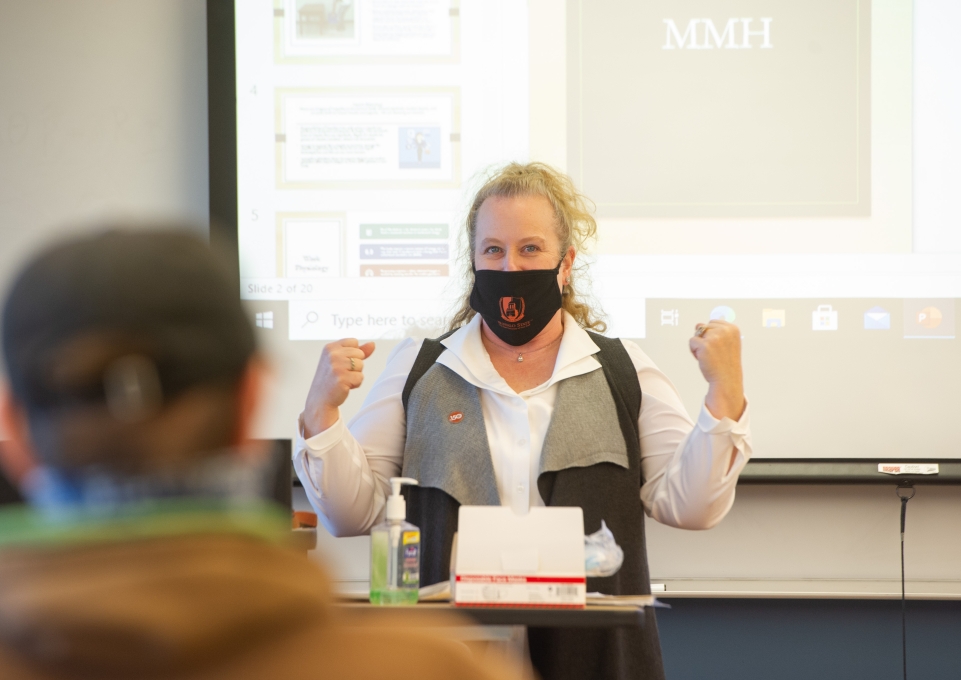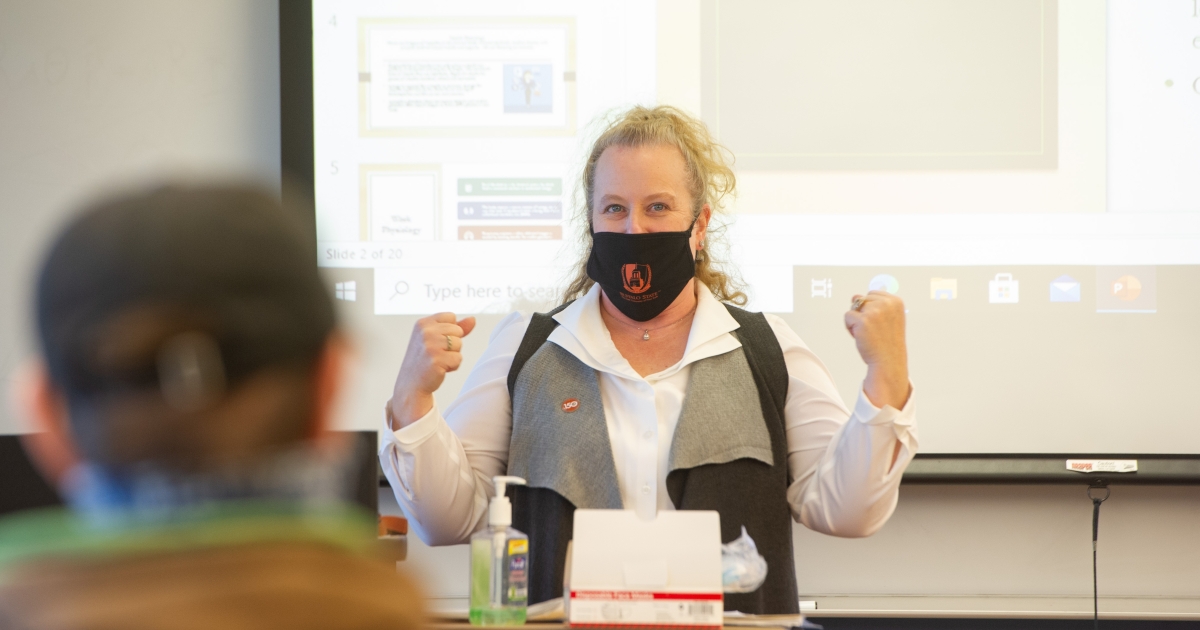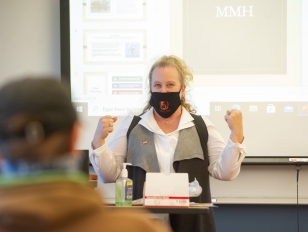
If you encounter Buffalo State College students donned in hazmat suits picking pieces of candy off the stairwells in the Technology Building, don’t be alarmed. This seemingly strange exercise is part of an important lesson—how to safely clean up after a hazardous accident—overseen by Elizabeth O’Neill, an environmental safety specialist and assistant professor of engineering technology.
“I have the students wear two pairs of gloves and weighted backpacks to simulate carrying oxygen,” explained O’Neill, ’94, ’04, about her Industrial Hygiene course. “I even pretend to wash them down after it’s over. It brings what we’re reading about industrial spills and accidents in manufacturing to life.”
Providing students with opportunities for hands-on learning, helping them grasp complex concepts, and preparing them for careers are what inspire O’Neill.
“I love supporting students,” she said. “I’ve helped them with résumés, mock interviews, and networking. I’ve got industrial contacts all over, and I’m not afraid to reach out to them for possible internships or jobs.”
To provide students with additional learning and networking opportunities, O’Neill co-founded the Buffalo State chapter of the Industrial Engineering and Operations Management Society (IEOM) with Jennifer Basile, assistant professor of business.
“I reached out to Jen because I wanted the business perspective, too,” O’Neill said, adding that the two were just getting everything in place in 2020 when the coronavirus pandemic hit. “This fall is the first time we’ve been able to meet in person.”
“I love supporting students. I’ve got industrial contacts all over, and I’m not afraid to reach out to them for possible internships or jobs.”
As part of the monthly meetings, the club schedules speakers and tours, including most recently to the R.M. Headlee Valves and Controls facility in Orchard Park, New York.
“Students got to see what the plant does, their safety mechanisms, and what products they’re selling,” she said. “The managers of the plant were impressed with the students’ knowledge about manufacturing and their thoughtful questions about their industry.”
O’Neill, who has raised five children, exudes a joyful and mothering vibe. Her office is filled with colorful artwork, cerulean blue curtains, an assortment of plants, and encouraging sayings. The office also speaks to a love of interior design—her first choice of study when she was an undergraduate at Buffalo State in the early 1990s.
“I was unsure about the job prospects at the time,” she said. “A friend recommended I try industrial arts. I really enjoyed it and found my focuses with safety and quality control.”
O’Neill went on to earn her master’s degree from Buffalo State in industrial technology. Through such positions as industrial hygienist and production manager, she developed site safety plans, trained employees on OSHA regulations, identified safety hazards, and applied quality control methods to manufacturing environments. The jobs, she said, were fascinating but required constant travel.
When she took a break to be home with her children, O’Neill helped found Saving Grace Outreach, a faith-based organization that provides food, clothing, and other essentials to residents in Cattaraugus County, where she lives.
“I want to help students figure out what their dream jobs are, and then find the stepping-stones to reach them.”
Also, between 2005 and 2010, she volunteered as a hazardous waste operations responder with Erie County Emergency Services. In this role, she would typically clean up oil spills on the highway and other smaller environmental accidents. One tragedy in particular is indelibly seared into her memory: the 2009 crash of Continental Flight 3407 in Clarence, New York, that killed 50 people.
Her duties included setting up the heater for the medical examiner tents and washing police cars, trucks, and other equipment that were in the containment areas.
“It was my first teaching experience helping a medical student with the decontamination process,” she said. “The fire departments, emergency responders, and medical teams all worked together to do what had to be done. I was never so proud to live in Western New York. All emergency responders train for these types of incidents, but we pray they never happen. And for an environmental safety engineer, a catastrophe like this shows the uniqueness of the profession.”
The desire to share that uniqueness with college students prompted O’Neill to pursue a doctorate in industrial engineering at SUNY Binghamton. At the same time, she taught part time, including advanced manufacturing courses through Buffalo State’s Continuing Professional Studies office.
Just weeks after earning her doctorate, O’Neill stepped back into a Buffalo State classroom as a full-time assistant professor, coming full circle. Her appointment filled a void left by the retirement of James Shea, associate professor of engineering technology, who taught O’Neill when she was a student. In addition to industrial hygiene, she teaches courses in BIM and CAD/CAM software, technical drawing, product safety, and ergonomics.
The latter, she said, covers more products than most people realize. For instance, O’Neill, an avid skier and adaptive snow-sports instructor, designed a rear handle for a sit ski with her teaching assistant Keith McDade, using the Solidworks program.
“It’s the same program that I teach to my undergraduate students,” she said. “I explain to them the varied ways in which ergonomics are used—from the height of a worktable to a billboard on the highway,” she said. “Ergonomics are so much more than office chairs.”
In all of her teaching, O’Neill is passionate about igniting new ideas in her students and encouraging them, the same way her professors encouraged her.
“I want to help them figure out what their dream jobs are,” she said, “and then find the stepping-stones to reach them.”
Photo by Bruce Fox, campus photographer.



